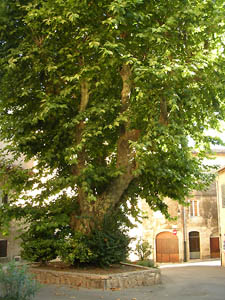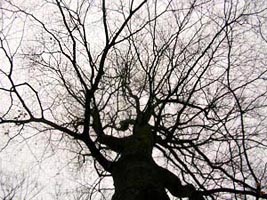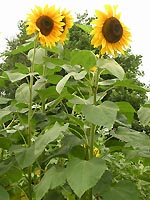The architecture of plant seems so simple: the roots that achieve water uptake and anchoring of the plant are in the soil. The leaves are spread in the air to maximize the exposure to light energy and gas exchange in order for the production of sugars by means of
photosynthesis).
The stem functions as the connecting column between roots and leaves. Easy.
TASK STEM GROWTH:
Design a developmental plan for stems of growing plants as if you would be an architect.
Suggestions:
- ]Read the paragraph here below, entitled "Background information on the architecture of a higher plant"
- Work in groups of two students and make a number of schemes (e.g. starting from image A) in which you will indicate where youn would place a certain function essential forthe survival of the plant. (think 3D!)
- You may also use clay of different colors and iron wire to make models.
- Plants do not waste their energy. Thus follow their example and be careful not to waste "construction material". (Now that you tried to create a stem yourself: aren't plants smart to make such elongated object, strong enough to sustain leaves, flexibleenough to allow growth, and light enough not to collapse!)
- The designs and strategies do not need to resemble any existing path in real stems. Originality is welcome!
- Final step: Compare your own design with those of other students and those known from plant anatomy in the following webpages.
Background information on the architecture of a higher plant
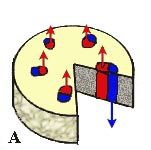 | Schematic cross-section through a stem: Xylem vessels for the upward transport of water
Phloem vessels for the downward transport of sugars |
The stem and side stems (
green arrows in the images here below) are provided with a tubing system (vascular bundles) in which water flows upward from the root to the leaves (
red-colored bundles in
A) and sugars move downward from the leaves to the other parts of the plant (
blue-colored bundles in
A).
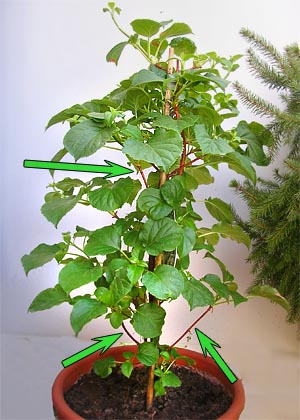 | Upper parts of a plant: side stems are indicated by green arrows. |
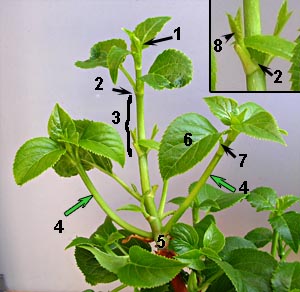 | Upper parts of a plant: 1 = apical shoot
2 = node
3 = internode
4 = side stem
5 = main stem
6 = leaf blade
7 = petiole
8 = axillary bud |
Branching stems, like tree branches also are in fact, fulfill also a task as "antenna pole" for the -photosynthetic active- leaves and for the flowers involved in reproduction. Ageing of the plant goes along with growth, so that an adapted development of among others the stem is needed. To grow, more primary substances (water, carbon dioxide, minerals) must be taken up, but also the capacity for the internal transport of water and sugars, mainly achieved through the stem, has to be tucked up. To carry the weight of the above-ground parts extra support and a well-balanced division of the load are required. The leaves and flowers must be distributed by the stems in such a way through the space that exposure to i.e. light (photosynthesis) and wind (dispersal of pollen and seeds) remain optimal. Meanwhile, the stem has to protect itself against desiccation and wounding and resist to pressure of wind and touch of animals.
In these web pages we will see examples of developmental steps occurring in stems to cope with the changing conditions during the growth of plants.
See next webpages on secondary growth in "real" stems.
